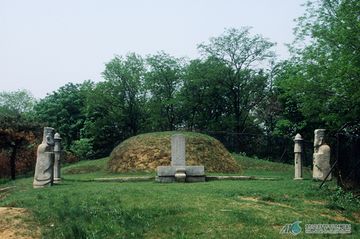효간공 이정영 묘역
| 효간공 이정영 묘역 Tomb of Yi Jeong-yeong |
|
 효간공 이정영 묘역, 한국민족문화대백과사전, 한국학중앙연구원. |
|
| 대표명칭 | 효간공 이정영 묘역 |
|---|---|
| 영문명칭 | Tomb of Yi Jeong-yeong |
| 한자 | 孝簡工 李正英 墓域 |
| 주소 | 서울특별시 동작구 사당동 산 32-79, 산44-70 |
| 지정(등록) 종목 | 서울특별시 유형문화재 제94호 |
| 지정(등록)일 | 1994년 5월 10일 |
| 분류 | 유적건조물/무덤/무덤/기타 |
| 시대 | 조선시대 |
| 수량/면적 | 분묘 1基, 석물 9基, 토지 308.6㎡ |
| 웹사이트 | 효간공 이정영 묘역, 국가문화유산포털, 문화재청. |
해설문
국문
효간공 이정영 묘역은 조선 후기 문신이자 당대 명필이었던 이정영(1616~1686)과 그의 부인 문화 류씨(文化柳氏)의 합장묘가 있는 구역이다. 묘역에는 봉분이 단분* 형태인 묘와 묘표(墓標), 상석(床石) 등의 다양한 석물(石物), 신도비** 등이 있다.
이정영은 호조 판서 이경직의 셋째 아들로, 인조 14년(1636) 문과에 급제하였다. 병자호란이 끝난 후에는 소현세자를 모시고 청나라 심양에 다녀왔다. 그 후 한성부 판윤을 거쳐 이조·형조 판서 등을 지냈다. 그는 서예에 뛰어나 여러 현판과 묘비에 글씨를 남겼는데, 「해남 명량대첩비」가 대표적이다. 사후(死後)인 숙종 37년(1711)에 ‘효간’이라는 시호를 받았다.
이 묘역은 17세기 말·18세기 초 분묘 제도를 잘 보여주는 자료로, 혼유석***, 향로석**** 등의 석물은 당시 석조 미술 양식을 대표할 만한 작품으로 평가된다. 주변에는 이정영의 선조인 이계수를 비롯한 전주 이씨 함풍군파의 가족묘가 조성되어 있다.
- 단분(單墳): 부부를 합장(合葬)하여 봉분이 하나인 묘
- 신도비(神道碑): 왕이나 고관의 무덤 앞 또는 무덤으로 가는 길목에 세워 죽은 이의 사적(事蹟)을 기리는 비석
- 혼유석(魂遊石): 영혼이 나와서 놀도록 한 돌이라는 뜻으로, 상석(床石)과 무덤 사이에 놓는 직사각형의 돌을 이르는 말
- 향로석(香爐石): 무덤 앞에 향로를 올려놓는 네모반듯한 돌
영문
Tomb of Yi Jeong-yeong
This is the tomb of Yi Jeong-yeong (1616-1686, posthumous name: Hyogan), a civil official and renowned calligrapher of the Joseon period (1392-1910), and his wife Lady Ryu.
Yi Jeong-yeong passed the state examination in 1636. In early 1637, Korea was invaded by the Manchu Qing dynasty and forced to recognize Qing as its suzerain. Following the invasion, Yi was entrusted with escorting Crown Prince Sohyeon (1612-1645) to the Qing capital (today’s Shenyang, China), where the crown prince was sent hostage as a guarantee of Korea’s surrender. Upon Yi’s return to Korea, he served in several high-ranking posts such as governor of Hanseong-bu District, minister of personnel, and minister of punishments. Yi was also known for his outstanding calligraphy, which is featured on several plaques and tombstones. His most well-known work of calligraphy is the Monument for the Victory at Myeongnyang Battle (Treasure), which was erected in Haenam, Jeollanam-do, to commemorate the historic battle that took place during the Japanese invasions of 1592-1598.
The tomb consists of an earthen burial mound with various stone sculptures in front, including a tombstone, table, incense table, statues of civil officials, and pillars. At the base of the hill, there is also a stele commemorating Yi Jeong-yeong’s life and achievements. The tomb exhibits the burial practices of the late 17th to early 18th centuries, and its stone sculptures are considered representative of the artistic aesthetics of the time. The other tombs on the hill belong to members of the Prince Hampung Branch of the Jeonju Yi Clan, to which Yi Jeong-yeong belonged.
영문 해설 내용
이곳은 조선시대 문신이자 명필이었던 이정영(1616-1686, 시호: 효간)과 부인 문화류씨의 합장묘이다.
이정영은 1636년 과거에 급제하였다. 이듬해 병자호란이 일어나 조선이 전쟁에서 패배한 후 소현세자(1612-1645)가 청나라에 볼모로 가게 되었는데, 이때 이정영은 세자를 호종하여 심양에 다녀왔다. 귀국한 후에는 한성부 판윤을 거쳐 이조·형조 판서 등을 지냈다. 그는 서예에 뛰어나 여러 현판과 묘비에 글씨를 남겼는데, 특히 임진왜란 때 왜적을 크게 물리친 명량대첩을 기념하기 위해 세운 해남 명량대첩비(보물)가 대표적이다.
봉분 앞에는 묘비, 상석, 향로석, 문인석, 망주석 등의 다양한 석물이 있고, 묘역 아래에는 이정영의 생애와 업적을 기리기 위해 세운 신도비가 있다. 이 묘역은 17세기 말 18세기 초 분묘 제도를 잘 보여주며, 석물은 당시 석조 미술 양식을 대표할 만한 작품으로 평가된다. 주변에는 이정영의 가문인 전주이씨 함풍군파의 가족묘가 조성되어 있다.
참고자료
- 효간공 이정영 묘역, 한국민족문화대백과사전, 한국학중앙연구원. https://encykorea.aks.ac.kr/Article/E0045841
- 효간공 이정영 묘역, 디지털동작문화대전, 한국학중앙연구원. http://aks.ai/GC08200486